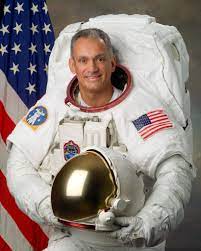John D. “Danny” Olivas is an exceptional individual whose life story takes us from the border city of El Paso, Texas, across the Rio Grande into the cosmos. His remarkable journey not only exemplifies the power of dreams but also underscores the vibrant Hispanic community that has been an integral part of his family since his great-grandfather, Valente Olivas, made the journey from Mexico in 1894. In this article, we will delve into the life and achievements of Danny Olivas, an astronaut whose contributions to space exploration have left an indelible mark.
A Dream Takes Root:
Born just three years before the historic Apollo 11 Moon landing, Danny Olivas’s fascination with space began at the age of seven during a family trip to Houston, Texas. There, at NASA’s Johnson Space Center, his father, Juan, revealed his occupation as a machinist crafting components for real spacecraft. This moment ignited a lifelong aspiration in young Danny—to join the ranks of astronauts.
Educational Pursuits:
Danny Olivas embarked on his academic journey by earning a bachelor’s degree in mechanical engineering from the University of Texas at El Paso. He furthered his education by obtaining a master’s degree in mechanical engineering from the University of Houston and ultimately completing a doctorate at Rice University in mechanical engineering and materials science. He also earned the distinction of being a certified professional engineer (PE) and gained valuable experience during his two-year tenure as a senior research engineer and technical program manager at the Jet Propulsion Laboratory in California.
The Path to Becoming an Astronaut:
Undeterred by initial setbacks, Danny Olivas persevered in his quest to become an astronaut. Finally, in 1998, at the age of 32, he was selected as one of 25 new astronaut candidates by NASA. After two years of intensive training as a mission specialist, he was primed for a flight assignment.
Preparation for Extravehicular Activities (EVAs):
Before embarking on his space missions, Olivas dedicated himself to robotics and extravehicular activity (EVA) projects, pivotal for the assembly of the International Space Station (ISS). Additionally, he immersed himself in NASA’s NEEMO program, participating in two underwater missions that simulated space conditions within the submerged Aquarius Reef Base in the Florida Keys.
Space Shuttle Missions:
Danny Olivas’ dream was realized when he participated in two space shuttle missions. His inaugural mission, STS-117 aboard Space Shuttle Atlantis in 2007, involved a series of EVA tasks, including the installation of truss segments, deployment of solar arrays, and other essential equipment. Remarkably, during this mission, he made history by repairing a damaged insulation blanket on the shuttle’s exterior surface during an EVA, becoming the first person of Mexican-American heritage to venture into space.
His second mission, STS-128 aboard Space Shuttle Discovery in 2009, aimed to expand the ISS’s scientific and storage capabilities with the installation of the Leonardo Multi-Purpose Logistics Module. Olivas logged an additional 20 hours of EVA across three spacewalks, further enriching his experience and contributions to space exploration.
A Unique Tradition and Philanthropic Initiatives:
Following each mission, Danny Olivas started a unique tradition—commemorating his achievements with a special memento: a pair of custom cowboy boots crafted by El Paso’s Lucchese Boot Company, each adorned with the emblem of the respective mission. He wore these boots proudly during work and public appearances.
Beyond his space endeavors, Olivas holds six U.S. patents and has earned various accolades for his technological innovations. After concluding his tenure at NASA, he assumed the role of director of the space technology research center at the University of Texas at El Paso. Additionally, he established a consulting company focused on engineering and research projects.
Olivas diversified his portfolio by authoring a children’s book titled “Endeavour’s Long Journey,” published in 2013 and available in both English and Spanish. His commitment to community welfare manifested in the creation of the Olivas Family Space For Everyone Foundation in 2020. This foundation aims to provide essential healthcare and legal support to immigrant children and families entering the United States.
Continuing the Journey:
Today, Dr. Danny Olivas continues to contribute to academia as a faculty member at the Engineering School of the University of Southern California. His story stands as a testament to the extraordinary heights that can be reached through unwavering determination and a deep connection to one’s heritage and dreams. Danny Olivas’ journey serves as a beacon of inspiration for aspiring astronauts and dreamers worldwide, showcasing the boundless possibilities of human exploration and achievement.
Read More
A Guide to Pre-Ordering Apple Products in the United States
Google’s Threat Analysis Group: North Korean State Hackers Target Security Researchers
Synthetic Human Embryos: A Revolution in Scientific Understanding
Unveiling the Rarity and Beauty of Pink Diamonds: The Lulo Rose Phenomenon
Personalized 4D Printed Implants Redefining Breast Cancer Treatment
Decoding the Enigma of Earth’s Oxygen Surge: Unveiling Volcanic Sulfur Dioxide’s Role
GOOGLE DEEPMIND: Google’s Stealthy AI Weapon to Spot Deep fake Images!
Pakistani Doctor Sentenced to 18 Years in the US for Assisting ISIS
Exploring the Marvels of Coral Reefs: Unraveling the Darwin Paradox
Historic Milestone Achieved: Chandrayaan-3 Successfully Lands on Lunar Surface
Unbelievable! ISRO’s Chandrayaan-3 Mission Set to Blow Your Mind – New Discoveries Await!
Frequently Asked Questions (FAQs)
Who is John D. “Danny” Olivas?
John D. “Danny” Olivas is an astronaut and engineer known for his remarkable journey from El Paso, Texas, to space exploration. He has made significant contributions to space missions and holds a unique place in the history of spacewalks.
What inspired Danny Olivas to become an astronaut?
Danny Olivas’ dream of becoming an astronaut was sparked during a family trip to NASA’s Johnson Space Center in Houston, where he learned about his father’s job as a machinist working on spacecraft components.
What is Danny Olivas’ educational background?
Danny Olivas holds a bachelor’s degree in mechanical engineering from the University of Texas at El Paso, a master’s degree in mechanical engineering from the University of Houston, and a doctorate in mechanical engineering and materials science from Rice University. He is also a certified professional engineer (PE).
How did Danny Olivas become an astronaut?
After several attempts, Danny Olivas was selected as one of 25 new astronaut candidates by NASA in 1998. He underwent rigorous training as a mission specialist before becoming eligible for space missions.
What space missions did Danny Olivas participate in?
Danny Olivas participated in two space shuttle missions: STS-117 on Space Shuttle Atlantis in 2007 and STS-128 on Space Shuttle Discovery in 2009. Both missions involved significant extravehicular activities (EVAs) and contributed to the assembly and maintenance of the International Space Station (ISS).
What is unique about Danny Olivas’ spacewalk achievements?
During his spacewalks on STS-117, Danny Olivas made history by becoming the first person of Mexican-American heritage to walk in space. He also performed a pioneering repair of the shuttle’s insulation blanket during an EVA.
What philanthropic efforts is Danny Olivas involved in?
Danny Olivas and his wife established the Olivas Family Space For Everyone Foundation in 2020, which provides healthcare and legal support to immigrant children and families entering the United States. This initiative was a response to family separation practices at the U.S. border.
What is Danny Olivas’ current role and contributions?
Today, Dr. Danny Olivas is a faculty member at the Engineering School of the University of Southern California. He also serves as the director of the space technology research center at the University of Texas at El Paso. Furthermore, he has authored a children’s book and continues to be involved in engineering and research projects.
What is the significance of the custom cowboy boots mentioned in the article?
After each space mission, Danny Olivas treated himself to a pair of custom cowboy boots featuring the mission emblem. These boots became symbolic mementos of his space achievements and were later donated to the Smithsonian’s National Air and Space Museum.
How does Danny Olivas’ journey inspire others?
Danny Olivas’ journey serves as an inspirational example of perseverance, dedication, and the realization of childhood dreams. His story encourages aspiring astronauts and dreamers to pursue their goals and make meaningful contributions to the field of space exploration.


